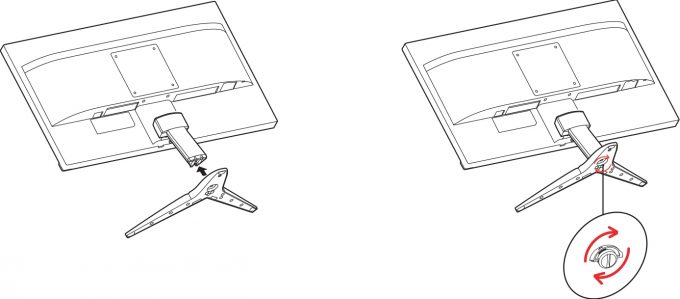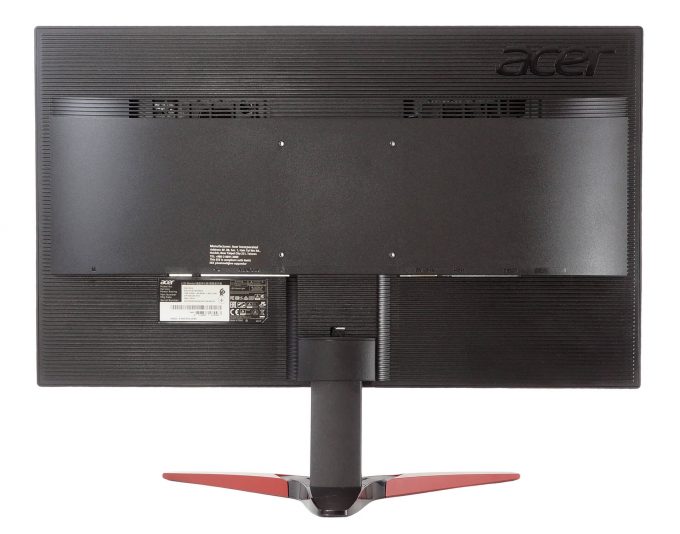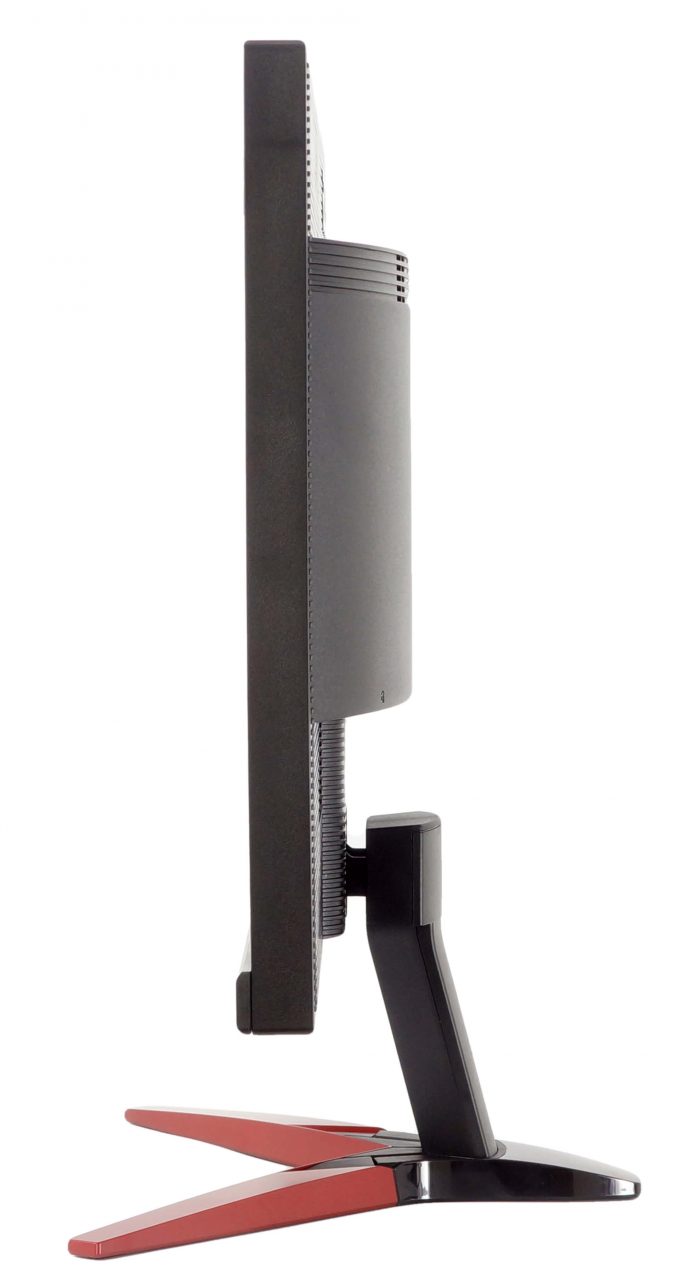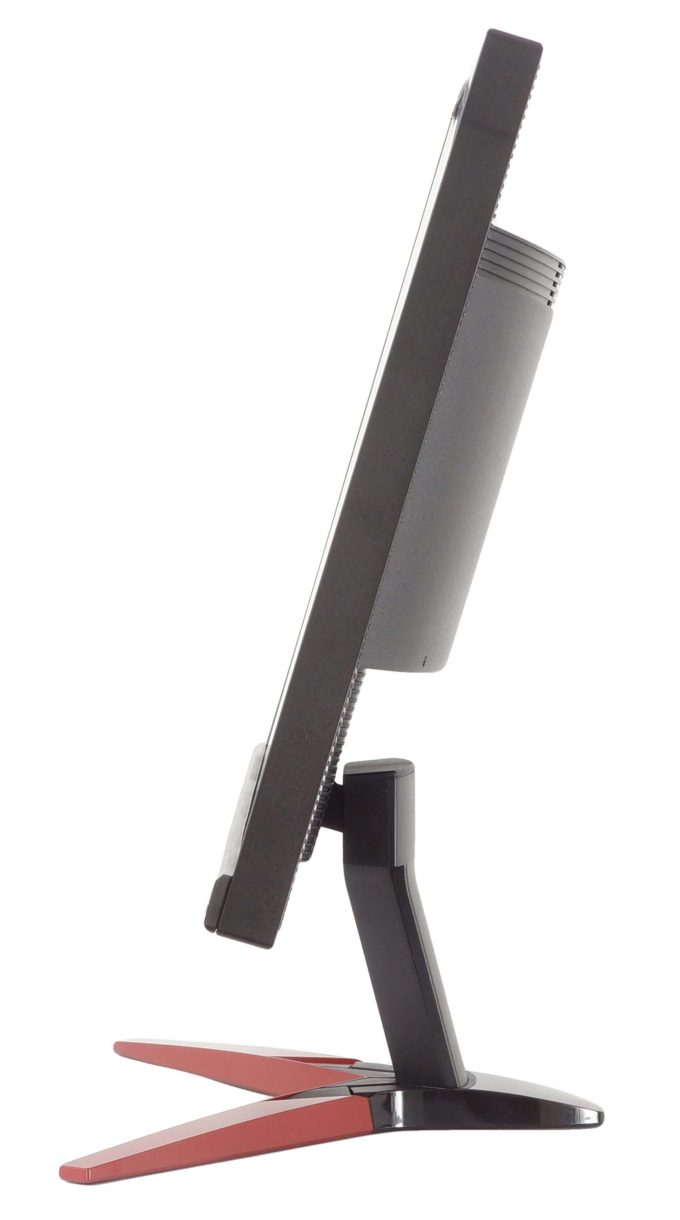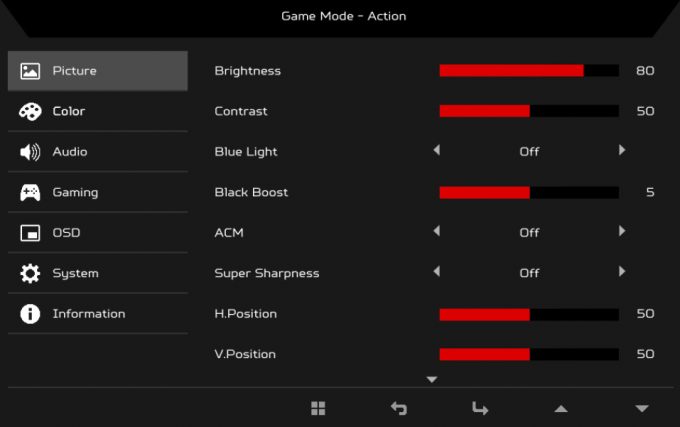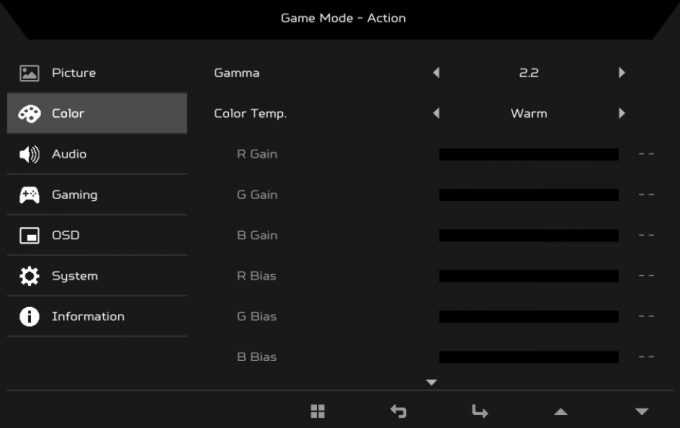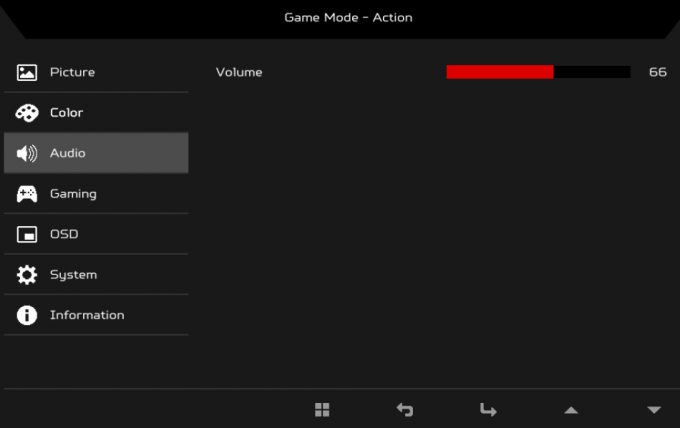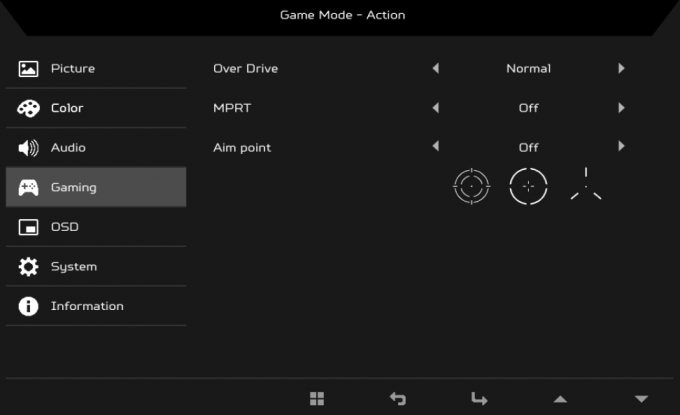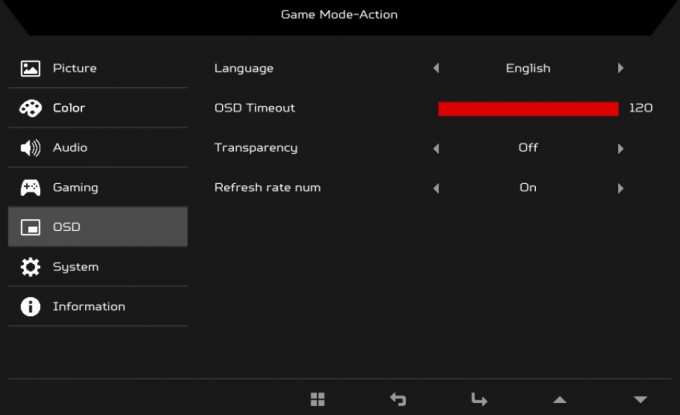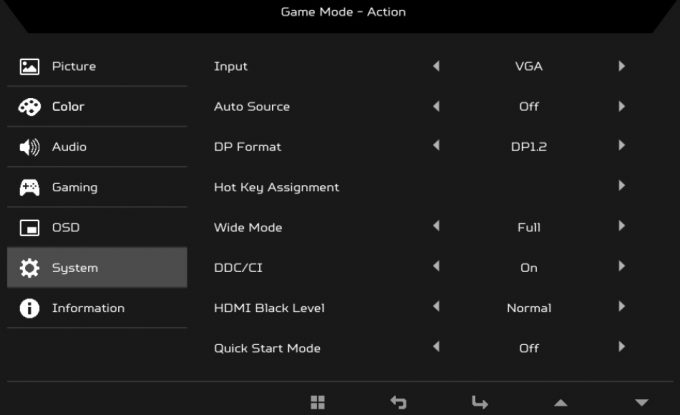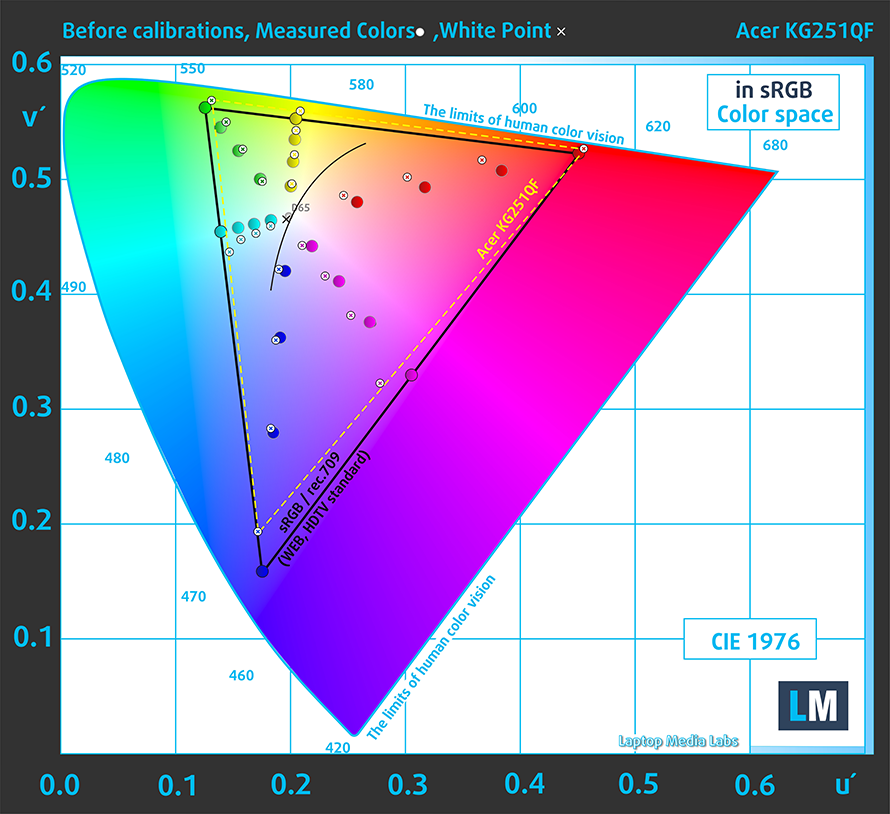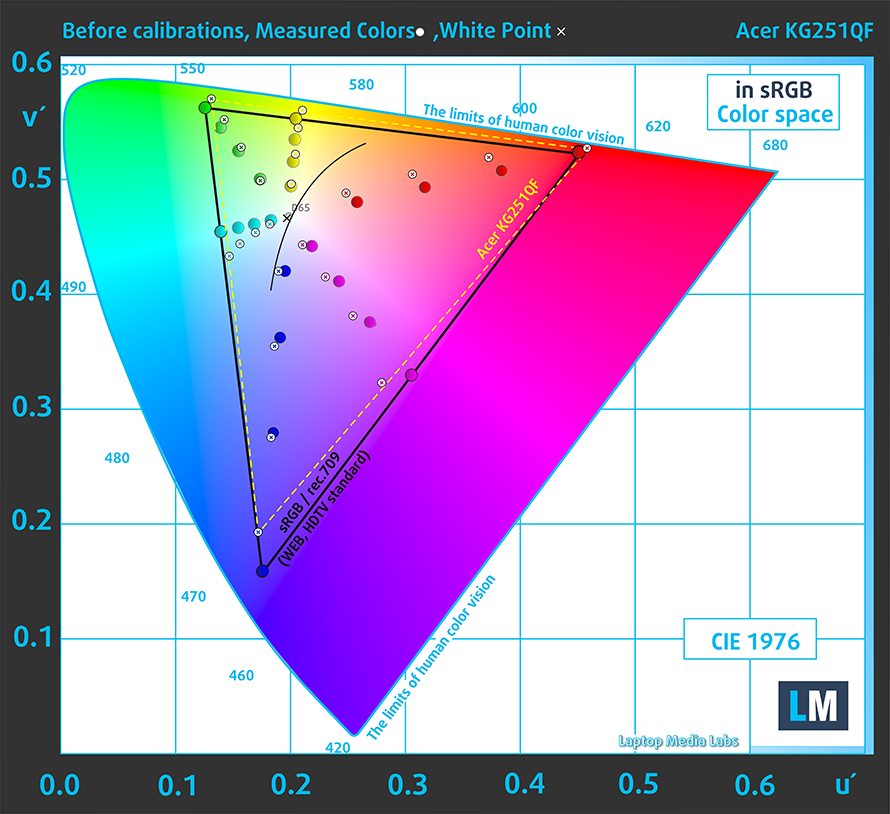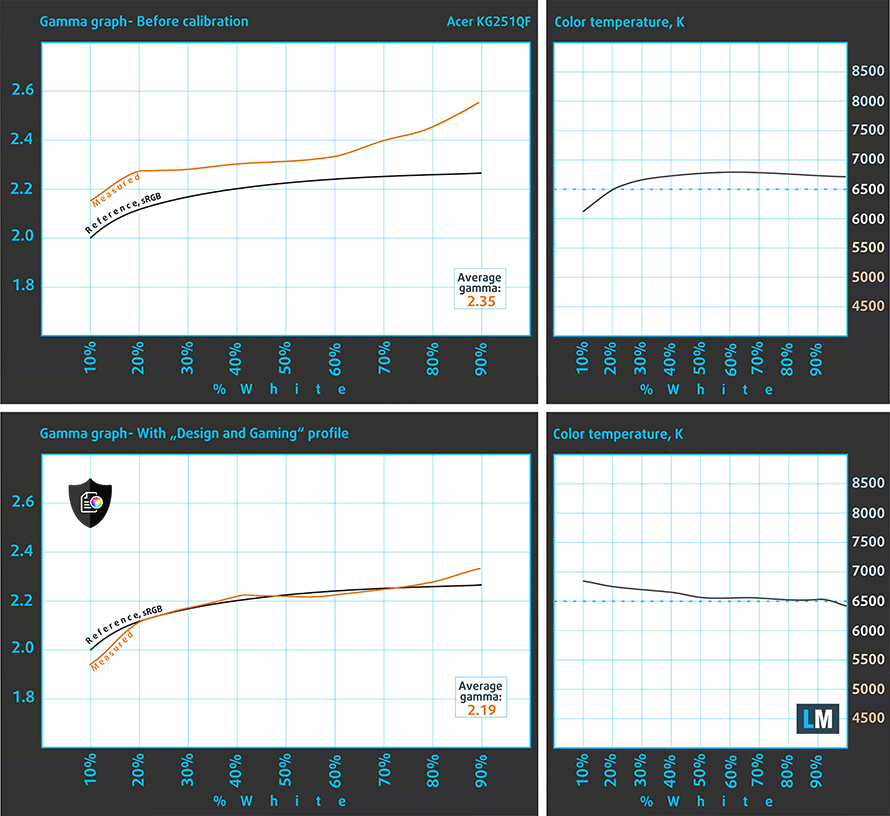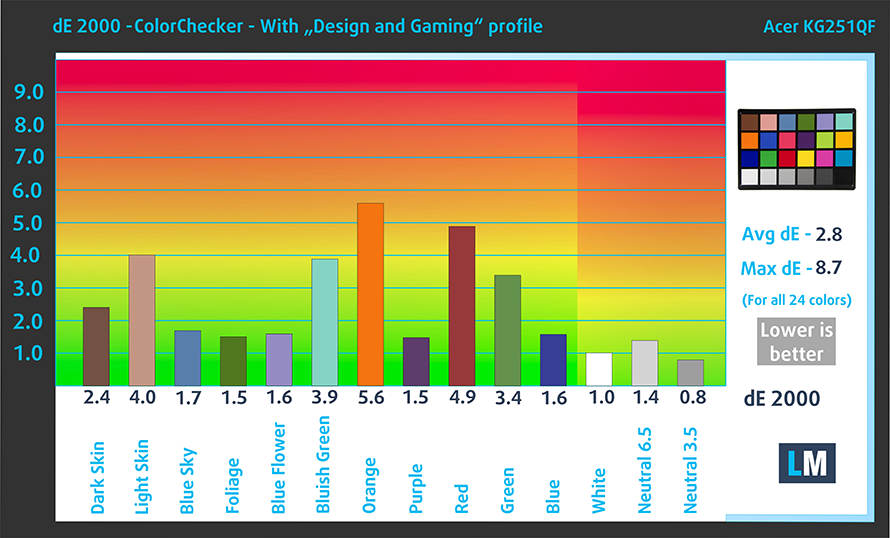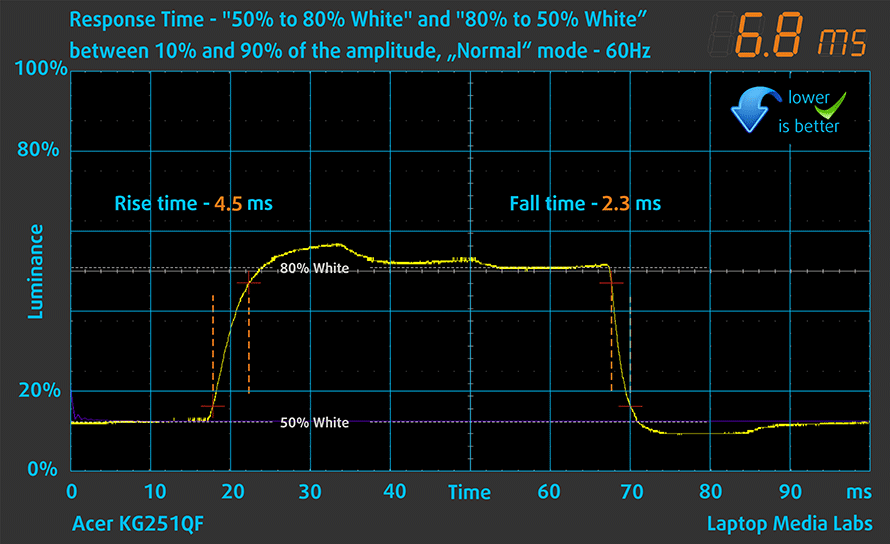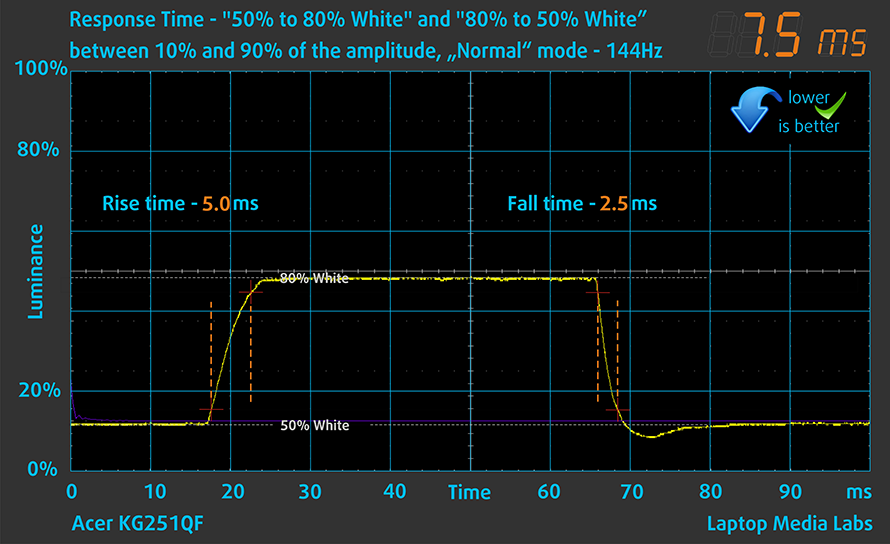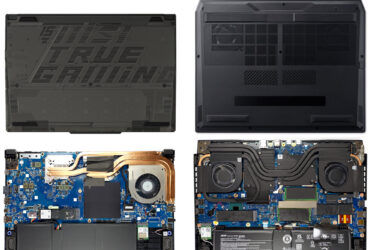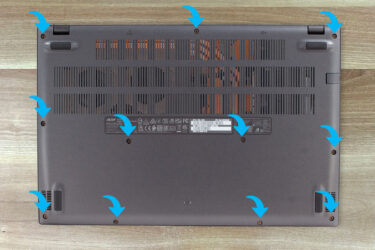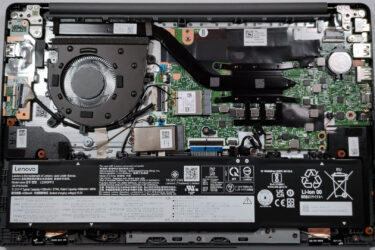Acer KG1 (KG251QF) review – a 144Hz TN panel that might surprise you
 Monitors are getting more and more attention in our office lately. One of the latest devices to hit our lab is the Acer KG1 (KG251QF). Ultimately, the KG1 series offers a wide variety of resolutions and refresh rates. Our particular device is fitted with a 1080p panel that ticks at 144 Hz. If you are a fan of vivid and punchy colors, you would probably be disappointed to learn that the panel is of a TN type.
Monitors are getting more and more attention in our office lately. One of the latest devices to hit our lab is the Acer KG1 (KG251QF). Ultimately, the KG1 series offers a wide variety of resolutions and refresh rates. Our particular device is fitted with a 1080p panel that ticks at 144 Hz. If you are a fan of vivid and punchy colors, you would probably be disappointed to learn that the panel is of a TN type.
However, the target group for this monitor is gamers. And what do gamers value the most – response times. Not only the nature of the panel is more favorable of quick reaction times of the pixels, but there is a dedicated Overdrive in the OSD menu – more on that – later.
So, let’s see if the KG1 (KG251QF) is going to be a better choice for gamers than the Nitro VG240Y Pbiip. TN versus IPS panels – same resolution, same refresh rate, but a different heart.
You can check the current price of Acer KG251QF here: Buy from Amazon.com (#CommissionsEarned)
Contents
Unboxing and setup
A pretty well-executed look on the box, for a monitor of this price. Inside, you’ll see a sandwich of styrofoam, which houses the display, itself, as well as the stand, the appropriate paperwork, and the cables. In terms of connections, you will get a DisplayPort cable, a DVI cable, and a power cord, which is the only thing needed to power the panel. Unlike with the power-hungry Predator XB3 (XB273UGS), all of the voltage regulation happens inside the monitor chassis.
Setting up the device is rather easy – just assemble the stand and attach it to the panel via the quick snap mechanism.
Design and construction
Perhaps expectedly, we are talking about an all-plastic design. The device itself is pretty lightweight at 3.70kg while including the stand will set you up at a total of 4.20 kg. As for the other measurements the panel has a thickness of 56mm, while the highest point of the display stays 430mm above the surface it sits on and sadly, there is no height adjustment here.
On the bright side, the top and side bezels are very slim, which has now become the standard for monitors in all price ranges. However, the bottom one is still a bit thicker and it houses all of the OSD menu buttons, as well as the Power On/Off key, and an indication light. Now, it is good that you can clearly see the navigation buttons, which makes it easier to go through the menu, but that indication light is pointing right at your face.
Sure, if you are looking at the top left corner of the screen, you wouldn’t notice it, but even if you are concentrated in the middle of the display, this bright blue sucker is knifing your eyes out. Sadly, we didn’t find any option in the OSD to switch it off, so you might want to use the good ol’ gaffer tape.
As we mentioned, there is no height adjustment to the stand. Honestly, this is quite a still unit, which only supports tilt movement. It definitely looks like a cost-reduction measurement.
Ports
Indeed, the port selection on this monitor is not extremely sophisticated, but it gots pretty much all of everything – an HDMI connector, a DisplayPort, and look who’s there – a DVI input!
OSD
The OSD menu is a quick and easy way to customize your device. This particular device has five navigation buttons. Click one, and you will have a choice of five quick menus – Quick Presets, Brightness adjustment, Audio adjustment, Input, and the full OSD.
If you dig inside the OSD menu, you would be able to find the Overdrive setting, which gives you some control over the response time of the panel. Additionally, there are color controls, brightness adjustment, Acer’s Aim Assist, which displays a large cursor in the middle of the screen to make you better in shooters. We find this to be particularly useless if you generally don’t perform well in such games. Check the images for full info about the OSD.
Display quality
Acer KG1 (KG251QF) is equipped with a 24.5″ (62.2cm) Full HD TN panel that has a refresh rate of 144Hz. The screen ratio is 16:9, and we are looking at a pixel density of – 90 ppi, and a pitch of 0.28 х 0.28 mm. The screen turns into Retina when viewed at distance equal to or greater than 97cm (from this distance one’s eye stops differentiating the separate pixels).

Surprisingly for a TN panel, Acer KG1 (KG251QF) has very respectable horizontal viewing angles. Yes, the image gets a little washed out as the angle grows, but still – impressive. In terms of the vertical viewing angles, however, everything comes into place. We offer images to evaluate image quality.

We measured a maximum brightness after Factory Reset and a 60Hz refresh rate of 387 nits in the middle of the screen and 352 nits as an average for the whole area, with a maximum deviation of 4%. However, as soon as you put the refresh rate at 144Hz the image starts to look quite differently – the maximum brightness becomes 470 nits in the middle of the screen and 430 nits as an average for the whole area, with a maximum deviation of 16% in the bottom left corner.
All of the tests and graphics to follow are made at 144 Hz.
In the illustration below you can see how the display performs from a uniformity perspective. The illustration below shows how matters are for operational brightness levels in the sRGB Display mode (approximately 140 nits) – in this particular case at 13% Brightness (White level = 142 cd/m2, Black level = 0.15 cd/m2).
Values of dE2000 over 4.0 should not occur, and this parameter is one of the first you should check if you intend to use the monitor for color-sensitive work. The contrast ratio is very good for a TN panel – 960:1.
To make sure we are on the same page, we would like to give you a little introduction to the sRGB color gamut and the Adobe RGB. To start, there’s the CIE 1976 Uniform Chromaticity Diagram that represents the visible specter of colors by the human eye, giving you a better perception of the color gamut coverage and the color accuracy.
Inside the black triangle, you will see the standard color gamut (sRGB) that is being used by millions of people in HDTV and on the web. As for the Adobe RGB, this is used in professional cameras, monitors, etc for printing. Basically, colors inside the black triangle are used by everyone and this is the essential part of the color quality and color accuracy of a mainstream display.
Still, we’ve included other color spaces like the famous DCI-P3 standard used by movie studios, as well as the digital UHD Rec.2020 standard. Rec.2020, however, is still a thing of the future and it’s difficult for today’s displays to cover that well. We’ve also included the so-called Michael Pointer gamut, or Pointer’s gamut, which represents the colors that naturally occur around us every day.
The yellow dotted line shows Acer KG1 (KG251QF)’s color gamut coverage.
Its display covers 94% of the sRGB/ITU-R BT.709 (web/HDTV standard) in CIE1976 (it is able to represent almost all of the colors found on the Web).
Our “Design and Gaming” profile delivers optimal color temperature (6500K) at 140 cd/m2 luminance and sRGB gamma mode. We’ve used the “Standard” preset after factory reset and brightness set to 13%.

And here we’ve used the “sRGB” preset after factory reset and brightness set to 13%.
We tested the accuracy of the display with 24 commonly used colors like light and dark human skin, blue sky, green grass, orange, etc. You can check out the results at factory condition and also, with the “Design and Gaming” profile.
Below you can compare the scores of Acer KG1 (KG251QF) with the “Standard” mode (left), “sRGB” mode (middle), and with the “Gaming and Web design” profile (right).
The next figure shows how well the display is able to reproduce really dark parts of an image, which is essential when watching movies or playing games in low ambient light.
The left side of the image represents the display with stock settings with the “sRGB” mode applied at 144Hz, while the right one is with the “Gaming and Web Design” profile activated. On the horizontal axis, you will find the grayscale and on the vertical axis – the luminance of the display. On the two graphs below you can easily check for yourself how your display handles the darkest nuances but keep in mind that this also depends on the settings of your current display, the calibration, the viewing angle, and the surrounding light conditions. Interestingly, at 60Hz the default settings show excellent results.
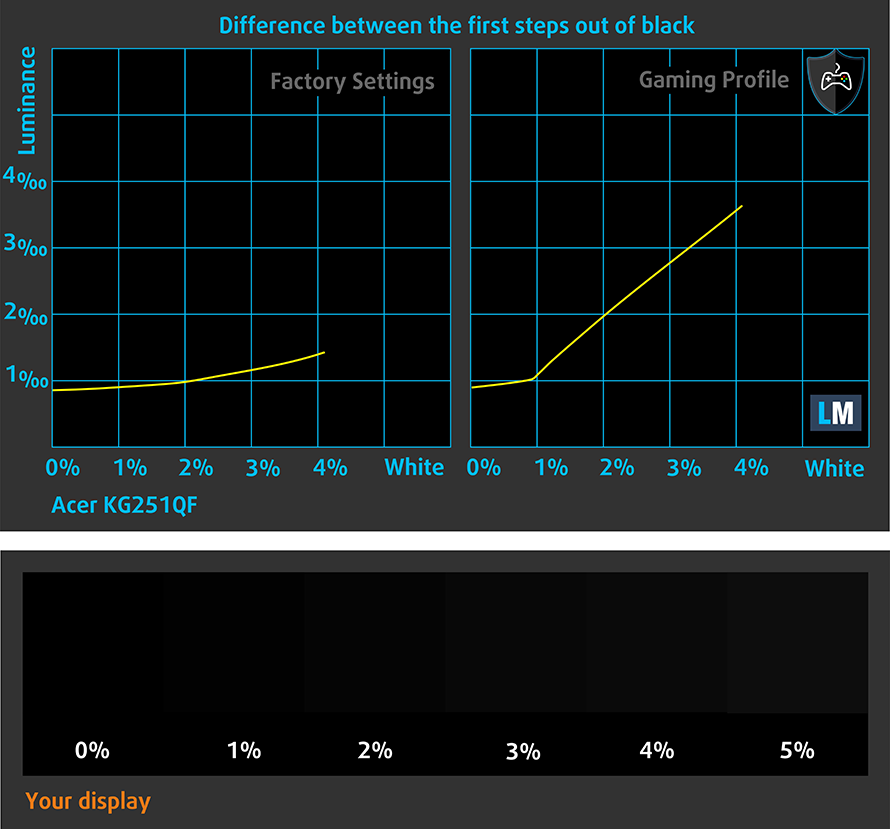
Response time (Gaming capabilities)
The response time of the pixels shouldn’t be slower than the refresh cycle of the screen (16.67 ms for 60Hz, 6.94 ms for 144Hz, and so on). Ultimately, this results in ghosting, caused by the pixel’s inability to change in that amount of time, thus continuing in the next frame. In order to battle with that issue, manufacturers use Overdrive. Essentially, this is a technique for RTC (Response Time Compensation). What does it do? Well, it supplies higher voltage to the crystals (in LCD monitors), which makes them switch their position faster. However, excessive levels of Overdrive can result in Overshooting, which transforms into inverse ghosting, coronas, and artifacts, obviously affecting the image quality in a negative way. This is why many manufacturers provide several levels of Overdrive, so you can choose which suits you best.
We test the reaction time of the pixels with the usual “Gray-to-Gray” method from 50% White to 80% White and vice versa between 10% and 90% of the amplitude.
We found that the “Normal” setting of Overdrive works best here.
PWM (Screen flickering)
Pulse-width modulation (PWM) is an easy way to control monitor brightness. When you lower the brightness, the light intensity of the backlight is not lowered, but instead turned off and on by the electronics with a frequency indistinguishable to the human eye. In these light impulses, the light/no-light time ratio varies, while brightness remains unchanged, which is harmful to your eyes. You can read more about that in our dedicated article on PWM.
Acer KG1 (KG251QF)’s backlight is not PW-modulated at any brightness level. This makes it comfortable for your eyes in this aspect even during long working periods.
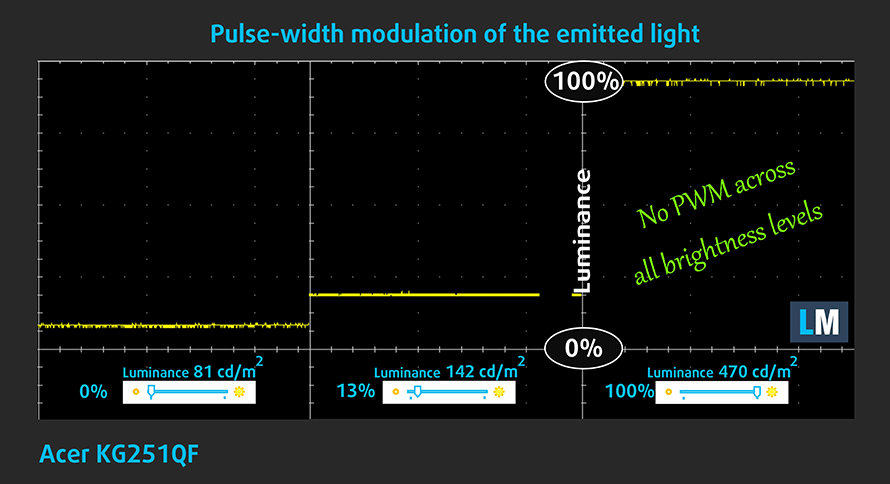
Blue light emissions
Installing our Health-Guard profile not only eliminates PWM but also reduces the harmful Blue Light emissions while keeping the colors of the screen perceptually accurate. If you’re not familiar with the Blue light, the TL;DR version is – emissions that negatively affect your eyes, skin, and your whole body. You can find more information about that in our dedicated article on Blue Light.
Buy our profiles
Since our profiles are tailored for each individual display model, this article and its respective profile package are meant for the Acer KG1 (KG251QF).
*Should you have problems with downloading the purchased file, try using a different browser to open the link you’ll receive via e-mail. If the download target is a .php file instead of an archive, change the file extension to .zip or contact us at [email protected].
Read more about the profiles HERE.
In addition to receiving efficient and health-friendly profiles, by buying LaptopMedia's products you also support the development of our labs, where we test devices in order to produce the most objective reviews possible.

Office Work
Office Work should be used mostly by users who spend most of the time looking at pieces of text, tables or just surfing. This profile aims to deliver better distinctness and clarity by keeping a flat gamma curve (2.20), native color temperature and perceptually accurate colors.

Design and Gaming
This profile is aimed at designers who work with colors professionally, and for games and movies as well. Design and Gaming takes display panels to their limits, making them as accurate as possible in the sRGB IEC61966-2-1 standard for Web and HDTV, at white point D65.

Health-Guard
Health-Guard eliminates the harmful Pulse-Width Modulation (PWM) and reduces the negative Blue Light which affects our eyes and body. Since it’s custom tailored for every panel, it manages to keep the colors perceptually accurate. Health-Guard simulates paper so the pressure on the eyes is greatly reduced.
Get all 3 profiles with 33% discount
Verdict
So what did our tests prove? First of all, the new generation TN panel, used in this monitor, is actually pretty good when it comes to viewing angles and contrast ratio. Although the former is nowhere near what you get from an IPS panel, it is good to see that the color shift is minimal from a horizontal point of view. However, once you try to look at the display from the top or the bottom, things start to become uncomfortable.
On the bright side, this is a gaming monitor, after all, so the chances are high you are going to look straight at the display most of the time. Interestingly, it also covers 94% of sRGB and while the colors are not the most accurate out there (even with our Gaming and Web design profile applied), they are still not too far off.
Additionally, the response times of the panel happen to be pretty nimble and we didn’t observe any overshooting in “Normal” Overdrive mode. Ultimately, this mode would be the best choice, as “Extreme” is introducing an inverse ghosting effect.
However, we have some complaints about the panel. First of all, make sure you are using it at 144Hz, and not at 60Hz, since this could make a big difference in the way you perceive the image. At least, this was our experience. The most notable change here was in the maximum brightness, as we got 470 nits at 144Hz and “only” 387 nits at 60Hz. Still, this is a very bright monitor, nonetheless.
One more thing we didn’t particularly like here was the stand. It only supports tilt adjustment and it is not the most stable one out there. The display shakes back and forth as you shake the desk. By the way, make sure you put some tape over the indication light because it is a bit too bright.
At the end of the day, the end price of this product makes it very appealing. Even though it has a TN panel, don’t be afraid to go for it. Indeed, the colors you get won’t be that accurate and the new IPS panels have supreme response times, but still, this if this is going to fit your budget – go for it, instead of a 60Hz IPS monitor.
You can check the current price of Acer KG251QF here: Buy from Amazon.com (#CommissionsEarned)
Pros
- Quick response times (for best results use the “Normal” Overdrive mode
- Adequate price
- DVI support
- Covers 94% of the sRGB color gamut
- Very high maximum brightness
Cons
- Quite narrow viewing angles (although surprisingly good for a TN panel)
- The stand supports only tilt adjustment and is a bit flimsy
- Switching between 144Hz and 60Hz results in a dramatic image difference

